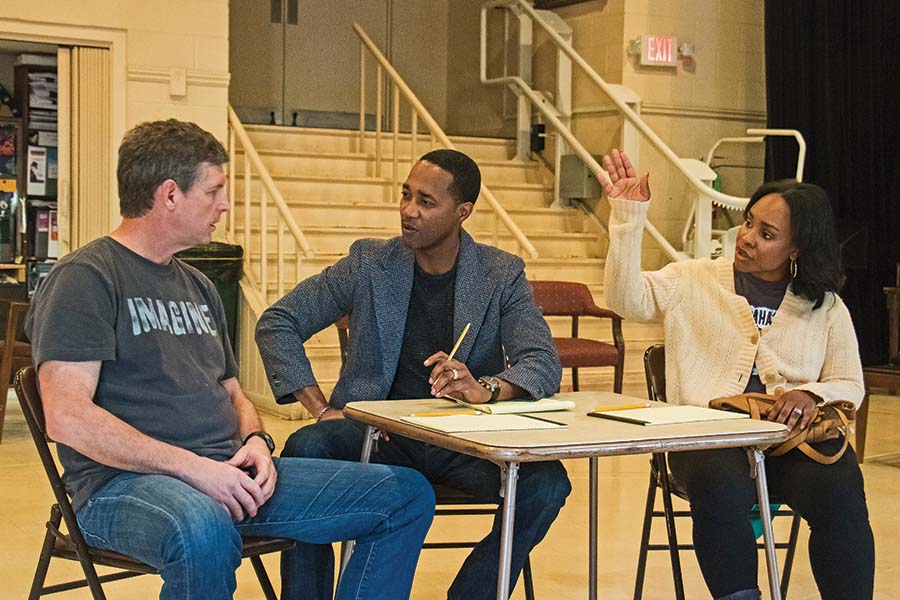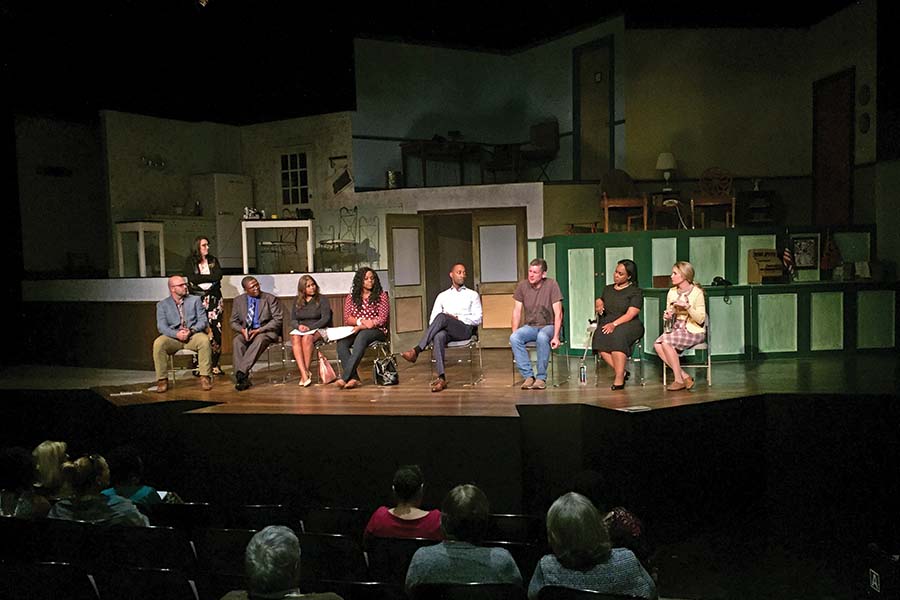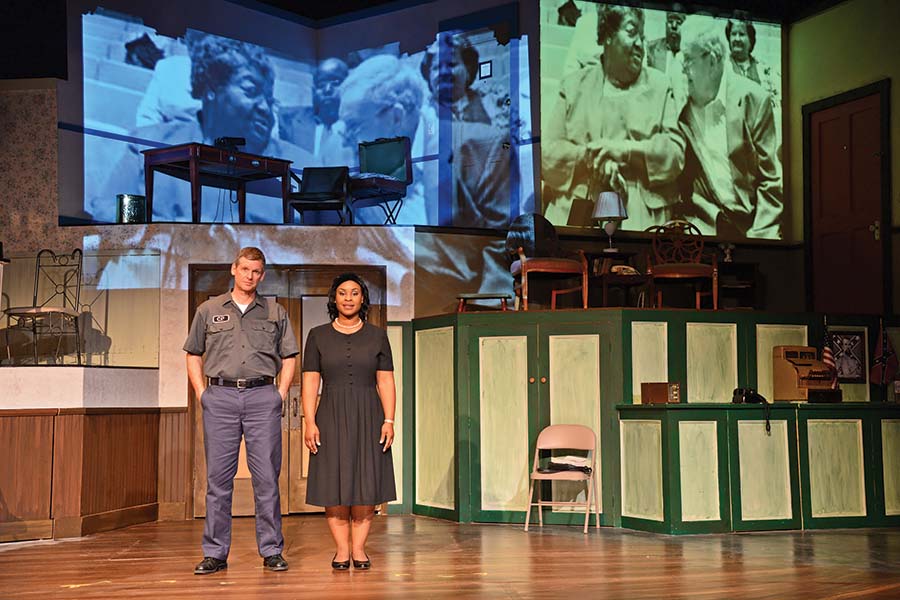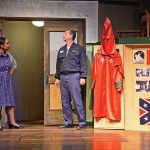Looking back, Francine Reynolds conceded that the decision to program Best of Enemies was, in her words, “naïve.”
Reynolds, artistic director of New Stage Theatre in Jackson, Miss., wasn’t even thinking about the then-upcoming 2016 election season, and, like many Americans, she couldn’t have imagined the outcome. In the ensuing climate of sharp political and social divides, Mark St. Germain’s 2011 play—based on the true story of a Ku Klux Klan leader and a Civil Rights activist who clashed over the desegregation of public schools in Durham, N.C., in 1971—took on a whole new meaning.
“I was thinking we’d celebrate how far we’ve come,” said Reynolds, who directed Best of Enemies at New Stage Feb. 28-March 12. “I still think that’s something to do—to look at what has occurred since the early ’70s and celebrate the progress that has been made. But I also think, realistically, it brings up how some things have not changed, how some things were maybe buried, how we weren’t paying attention to what was going on in people’s minds.”
In the past year, a number of events have put the issue of desegregation back in the spotlight. Last spring, 62 years after the landmark Brown v. Board of Education decision, the U.S. Government Accountability Office reported that segregation in schools is getting worse, not better: As of 2014 the number of U.S. schools with majority black or Hispanic students eligible for free or reduced-price lunches has almost doubled, from 9 percent to 16 percent, since 2001.
That same week, the Mississippi town of Cleveland made national news when a federal judge issued a long-overdue ruling mandating desegregation in the town’s middle and high schools. Most recently the confirmation of Betsy DeVos as the nation’s Secretary of Education continues to raise concerns over the lack of diversity in public schools, largely due to DeVos’s vocal support of “school choice,” which opponents fear will only further legitimize the institutionalized segregation of U.S. schools.
“In a year where the legislature is revisiting how we fund public schools—yes, this is really an important story when it comes to desegregating the school system,” noted Reynolds. “So are our conversations about the play reflecting what happened in the past, or are they about what’s occurring now?” She said she’d like the answer to be “both”: “I really want the conversation to be not only about the past but also about what’s happening right now.”
New Stage Theatre was founded on the principle of desegregation. In 1966, when the city’s Little Theatre was operating on a members-only model that conveniently dictated who was and who was not allowed to attend the theatre, New Stage launched its inaugural season in an old church with Who’s Afraid of Virginia Woolf?—a bold first offering, considering the time and place—and opened their doors to Jackson’s first racially integrated theatre audience.
Since then New Stage has set the standard for professional theatre in Mississippi, with a 364-seat mainstage space, an annual operating budget of roughly $1 million, and about 2,400 annual subscribers. The programming these days is often geared toward audience-friendly fare (the current season includes standards like Steel Magnolias and Our Town, alongside family shows like A Christmas Story, the Musical), but Reynolds remains committed to programming challenging works each season as well.
“We have an obligation to present a variety of material, including things that affect our community,” Reynolds said. “I feel like any play that deals with Civil Rights issues is important to do in Jackson, Miss.”

Best of Enemies opens with a flashback to April 4, 1968, the day Martin Luther King Jr. was assassinated in Memphis, Tenn. The play bangs out two scenes in quick succession: C.P. Ellis, the Exalted Cyclops of the Durham chapter of the KKK, leads his fellow Klansmen in a rousing cheer; then we see the African-American Civil Rights activist Ann Atwater at the Durham mayor’s office, demanding an audience with the mayor and threatening to throw an unsympathetic receptionist out the nearest window.
The action then jumps to 1971, and a narrative unspools that pits Ellis and Atwater against each other in a series of town hall meetings orchestrated by Bill Riddick, an African-American community organizer sent to Durham by the Department of Education. As Ellis and Atwater butt heads in and out of the meeting hall, the pair eventually find common ground in their economic and social class, and in their commitment to providing their children with better lives than their own.
The premise risks dampening the dramatic impact of this unlikely history, since audiences know in advance that the battle between the two adversaries will end in solidarity. The challenge for Reynolds and her actors was imbuing the play’s straightforward plot—told in a series of short, quick-moving scenes—with an emotional heft that isn’t always obvious in the script.
Prior to the first day of rehearsals, Reynolds gave the cast a reading assignment: The Best of Enemies: Race and Redemption in the New South by Osha Gray Davidson, the book that inspired St. Germain’s play. In examining the playwright’s source material, along with other portrayals of Ellis and Atwater (including Studs Terkel’s interview with Ellis, “Why I Quit the Klan,” and the documentary film An Unlikely Friendship), the cast set out to develop and inhabit the lives of their characters.
Rus Blackwell, a Mississippi native now based in Orlando, Fla., had the unenviable task of playing the KKK agitator. His goal, the actor said, was to block out the bigotry and hate and focus instead on the character’s core beliefs: love of God, country, and family. It sounded good in theory, but it became much harder in the early rehearsals as it came time to spews his character’s litany of awful, offensive things, including liberal use of the “N-word.”
“I was all about it,” said Blackwell with a shake of his head. “I was like, ‘Yeah, this is what I want to do.’ Then when I showed up and really started working on stuff, I got a little sick, and I got a little scared to go to rehearsal, to be honest—because now I had to say these words out loud for everybody to hear, looking somebody in the eye.”
Marci J. Duncan, who played Atwater and was on the receiving end of those words, found the process even more challenging.
“I’m not going to lie, the first times hearing Rus saying those words—one time in particular—I wanted to cry,” she said. “Everything that C.P. has to be, and those words coming at me—all of a sudden you’re like, ‘Whoa!’”
After a week of rehearsals, the exchanges were still emotionally charged, but the discomfort had largely dissipated. The settling-in not only gave the rehearsal room a genial vibe in between scene work; it also freed up the actors to find the tenderness in later scenes when the characters inch closer to reconciliation.
At that point, said Blackwell, the goal was to concentrate on “finding the music of the play, not only so we can play the notes, but so we can play the jazz—so that we can play in between the notes, and over the notes, and under the notes.”
While the actors were finding their groove in rehearsals, most of them were also engaging with the play’s subject matter on their own time, since three of the four cast members work as educators. Yohance F.A. Myles, who played community organizer Riddick, is an assistant professor of theatre/film acting at Jackson State University, a historically black university. Myles, who describes himself as a product of “an all-black middle school, an all-black high school, all-black college,” said that he worries about his students experiencing “culture shock” after college.
“I’m always telling them that the dynamic of the world is even bigger than the HBCU,” he said, using the acronym for historically black college and university. “You can’t just graduate from here and just say I’ve had ‘the black experience,’ as we’d call it, and act like there’s no other races that exist outside of this little box that you’re in right now.”
Jessica Wilkinson, who played Ellis’s white wife, Mary, teaches high school English at one of Jackson’s private prep schools. Originally established as a “white flight” haven in the years following desegregation, the school last year hired a “chief diversity officer,” a sign that administrators recognize the school’s problematic past and are rethinking its role in the community. In a classroom discussion of Elie Wiesel’s Holocaust memoir Night, Wilkinson brought up Best of Enemies.
“Teachers have a platform to talk to students about this stuff,” she pointed out. “You just can’t forget. You can’t sweep things under the rug and pretend like things didn’t happen. It’s important to talk about them and remember what happened in the past so they don’t happen again.”
But having a group of educators in the cast also added some logistical challenges. During one weekday rehearsal, Wilkinson arrived later than the rest of the cast, as she had to teach through the end of the school day; Myles ducked out early and headed back to campus, where he was directing a student production of Joseph A. Walker’s The River Niger.
Duncan’s teaching obligations kept her stretched thin too. She lives 200 miles away in Mobile, Ala., where she’s an adjunct instructor at both the University of South Alabama and the University of West Florida in nearby Pensacola. Her commute between work and rehearsals covered three different states.
In the car, Duncan was either working on her lines (she made a recording that she could play back via the car radio’s Bluetooth connection) or listening to National Public Radio. The news reports rolling in during the first month of the new presidential administration—the women’s march, the immigration ban, the links to white nationalism—underscored the importance of a story like Best of Enemies.
“The conversations that I’m listening to on NPR, and hearing about different things that are happening now, it gives me kind of a sick feeling, because it’s like it’s the same types of issues that we’re talking about in the play,” Duncan lamented. “So then you start thinking: I know we’ve made some gains! I know that, because of the simple fact I’m coming and going as I please, I have these liberties, I’ve been afforded the opportunity to go to college and get my degree. So I know things have progressed—but have they progressed to the point where this play is no longer relevant? No.”
There were some concerns among the cast that after a contentious election and the relentless news cycle that followed, audiences might be burned out on politics and shy away from Best of Enemies. And not just because of recent turns of events: Reynolds acknowledged that some New Stage patrons—not all, or even most, but some—grumble when she programs plays that deal with issues of civil rights.
“It’s not always fair, and it’s not always true, the way people think of people who live in Mississippi,” said Reynolds. “But there’s a flip side to that: There is a group of people who don’t want to see this, don’t want to revisit this, don’t want to relive this, may not see the value of it.”
And on the day before the show opened, ticket sales reflected those concerns.
“At this stage, for all of our other shows this season, at least one of the performances has been sold out,” Reynolds noted. “That’s definitely not the case for this show. This is not a surprise for me, though. I kind of know that going in, that this is a heavier issue.”
It probably didn’t help that marketing materials for Best of Enemies depicted the T in the word “Best” as a large burning cross. Reynolds fretted that potential ticket-buyers might think the production featured a cross-burning onstage, which it did not. (Likewise, when Reynolds mounted The Whipping Man by Matthew Lopez in 2014, she said “people were concerned that they were going to see someone being whipped.”)
Another strong visual image that threatened to overshadow the play’s themes of redemption and reconciliation were the shiny red Ku Klux Klan robes made by costume designer Lesley Raybon. In rehearsals for the opening scene, in which Ellis is presiding over a Klan meeting, Reynolds and the cast questioned whether he should appear in full KKK regalia, including the imposing pointed hood. Do KKK-ers only wear their hoods in public to protect their identity, they wondered, or do they wear them in private too? By the first dress rehearsal, the robe had been cut from the opening scene altogether, though it did make an appearance—hood and all—in a later scene, to dramatic effect.
In the early stages of planning, Reynolds envisioned a minimalist set design that emphasized the characters and their relationships over a defined sense of place. “We’re not going to realize those locations physically as you might in some plays,” she said at the time. “We’re definitely not going to realize those locations—they’re going to be suggested.”
A few weeks later, it seemed that Reynolds’s ideas either changed considerably or never quite gained the concurrence of Richart Schug, New Stage’s resident scenic designer, who was hammering away at an ambitious multilevel set. It included three platforms that served as the main characters’ living spaces, plus an open staging area that could quickly transform into a meeting hall, a gas station, a hospital room, or whatever else the script required. Video projections of black-and-white photos helped set the scenes with vintage images of Klan rallies, Civil Rights protests, and newspaper clippings from the era.
When asked about the discrepancies between Reynolds’s stated vision and his set, Schug gave a good-natured laugh.
“Well, first off, I have no clue what Francine’s vision is most of the time,” he said. “I just like having the play anchored somewhere, as opposed to all off in some other place, some other time, something we can’t really relate to.”
The design’s multiple playing areas were intended to help with the show’s quick pace, he pointed out, so the production wouldn’t get slowed down by moving things on and off the stage during the numerous scene changes. Schug also used the stage’s trap door and other mechanics to make set pieces appear and disappear quickly. But in addition to the practicality of the design, Schug’s set was attuned to the play’s message of common ground.
“I figured I would give everyone their own camp,” said Schug. “You can see each one of the characters in their own world, in their own living environment, and how they really aren’t that much different. They’re living literally right next door to each other on the stage set.”

On opening night the crowds turned out. The theatre was nearly full (if not quite sold out) at the opening curtain, and a pre-show forum on “Strength, Community, and Real Progress for Today,” hosted by the William Winter Institute for Racial Reconciliation, packed the theatre’s meeting room and ran right up to the play’s scheduled start time. Reynolds seemed a little harried but relieved.
“I hate a late curtain,” she declared, rushing from the meeting room to the mainstage. “But oh well!”
Actors Blackwell and Duncan came out swinging, establishing their characters as powerful forces. Neither showed a hint of weakness in the face of the other’s scorn and loathing. Between them was Myles, as the ever-cool Riddick, unfazed by the anger swirling around him. Apart from it all was Mary, played by Wilkinson—a reminder that amid the battles over policy and politics, the bills still have to get paid and the diapers still have to get changed.
The cast found small moments of humor and empathy throughout. But even hints of the inevitable reconciliation between Ellis and Atwater did little to relieve the dramatic tension, thanks to constant reminders of what’s at stake in the standoff between tolerance and violence.
After getting pushed closer and closer together, St. Germain’s play has Ellis and Atwater finally make peace, and even, in the play’s most touching moment, embrace. The emotion in the house on opening night was audible. The audience cooed and murmured, rustled for tissues, and continued to sniffle well into the next scene.
One could imagine a softer-headed staging of Best of Enemies that might focus on the redemption of Ellis at the conclusion of the play’s narrative arc. Atwater, after all, is on the right side of history, so the trajectory of her character could potentially be taken for granted. But Reynolds’s production treated Ellis and Atwater as true equals, hard characters who soften in their views of each other but only grow steelier in their commitment to fairness in the face of adversity, whatever the cost.
After the show, panelists from the pre-show forum joined the cast onstage to share reactions to the play and answer questions from the two dozen or so audience members who stayed behind to chat. Though local media outlets in Jackson cover New Stage, they don’t review the theatre’s productions, so these discussions are an important element for audiences who want to process what they’ve seen. Not surprisingly, the conversation focused on conflict and confrontation as much as reconciliation.
Noel Didla, a Jackson-based community activist, credited the production for facing the tough stuff head on, which she said often gets “oversimplified” in feel-good narratives of hope. Rather than glossing over the difficult work being done—and yet to be done—by those speaking truth to power, she said Best of Enemies was a reminder of the challenges that lie ahead.
“When we talk about race among different groups and we address issues such as antiracism, a lot of times people have this visual of hugging it out, eating food, and singing ‘Kumbaya’ and holding hands, but you guys have shifted that visual. You guys have shifted that visual at a time when it’s necessary for us do so because of what’s happening in our state and in our country.”
Brad Rhines is an arts writer and critic based in New Orleans.















